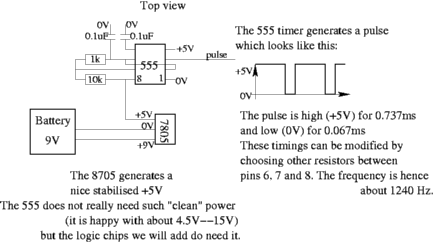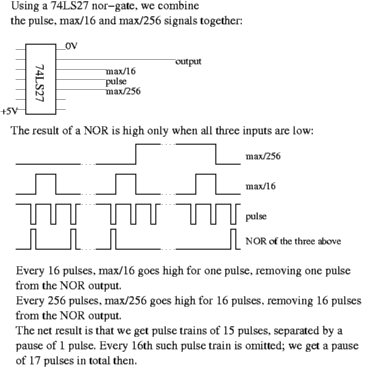Welcome to the
Hydroaeropropulsion Rocket Research Labs
homepage!
6 juli 2003
The electronics finally seem to get together. I exchanged a 74LS21 and-chip
for a 7427 nor-chip (I wanted a 74LS27 but those were not available in
my local electronics shop) and fixed a few remaining mistakes in the wiring.
The result is that you now can hear about four interruptions per second in the sound.
This is easy to explain: 1240 times a second, it emits a pulse,
but every 16th is dropped; so there are 77.5 dropped pulses per second.
This is probably not audible except that the timbre of the sound will change
slightly (77.5 Hz is four octaves lower than 16Hz). But every 16th of such
pulse trains is also dropped, so this happens at a frequency of 4.84Hz,
which the human ear does not interpret as a tone anymore but as a discrete
rhythm.
For those interested, here is a short explanation of the workings of the electronics:



The NOR of the three signals described above is then sent to a transistor
for amplification and fed to the speaker.
The amplification stage has a changable resistor; 1000 ohm gives
a fairly calm sound, 370 ohm is a bit louder and just inserting a
small piece of wire (0 ohm) gives a sound that is very reminescent
of a loud beeping alarm clock early in the morning ...
Good that it's sunday today, or half the department would probably think
some kind of fire alarm went off :-)
I made a test recording where I held the mike first close to the
speaker, then moved away for a metre, waited a bit, moved away to two
metres, waited again, and then reversed the procedure. The upcoming days
I'll try to analyze that sample and to work out a way to extract those
distances programmatically.
This is what the (amplified) sample looks like:
 This pattern has a silence about every 0.2 seconds.
So what we see here is 15 pulse trains (of each 15 pulses)
followed by a pause of 17 pulses, and we predicted that such a
17-pulse pause would happen 4.84 times a second, so every 0.20661
second we should see the same pattern. Phew, so far everything works out nicely!
This pattern has a silence about every 0.2 seconds.
So what we see here is 15 pulse trains (of each 15 pulses)
followed by a pause of 17 pulses, and we predicted that such a
17-pulse pause would happen 4.84 times a second, so every 0.20661
second we should see the same pattern. Phew, so far everything works out nicely!
Let's zoom in a bit on a single copy of the pattern:
 What we see here are 15 pulse trains of 15 pulses each.
How would a single pulse train look like?
This are two pulse trains:
What we see here are 15 pulse trains of 15 pulses each.
How would a single pulse train look like?
This are two pulse trains:
 and this is a single one:
and this is a single one:
 Let's study the missing pulse in more detail:
Let's study the missing pulse in more detail:
 Writing a program that counts the pulses seems not that easy.
Writing a program that counts the pulses seems not that easy.
Let's also have a closer look at the 17-pulse pause between each 15
pulse trains:








